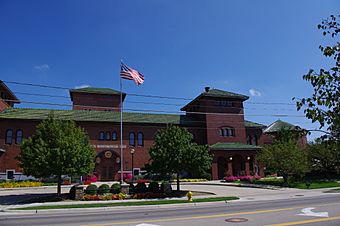Monroe Avenue Water Filtration Plant facts for kids
Quick facts for kids |
|
|
Monroe Avenue Water Filtration Plant
|
|
 |
|
| Location | 1430 Monroe Ave. NW, Grand Rapids, Michigan |
|---|---|
| Area | 6 acres (2.4 ha) |
| Built | 1910 |
| Built by | Gentz Brothers |
| Architect | Hering & Fuller, R E. Harrison |
| Architectural style | Romanesque Revival |
| NRHP reference No. | 02000815 |
| Added to NRHP | July 31, 2002 |
The Monroe Avenue Water Filtration Plant is a historic building in Grand Rapids, Michigan. It's located at 430 Monroe Avenue NW. This plant was built in 1910 to clean the city's water. It was probably the first water filtration plant in Michigan.
In 1945, something very important happened here. This plant was the first place in the United States to add water fluoridation to public water. This helps prevent cavities! The building was added to the National Register of Historic Places in 2002. Today, it's no longer a water plant. It's an event center called Clearwater Place.
Contents
Why Grand Rapids Needed Clean Water
By the 1870s, the city of Grand Rapids needed a better way to get clean water for everyone. Money was set aside in 1874 to build a water reservoir. But by the early 1900s, people really wanted a new source of clean water. The water from the Grand River needed to be cleaned before people could drink it.
In 1910, the city approved money to build a special plant. This plant would filter and clean the river water. They hired famous engineers Rudolph Hering and George Warren Fuller from New York City. These experts designed the new plant.
Building the Plant
Construction of the plant began in 1910. Gentz Brothers of Grand Rapids was the main company that built it. The plant started working in 1912. It was a big success right away! It greatly reduced illnesses caused by dirty water in the city.
However, Grand Rapids grew quickly. By the 1920s, the plant needed to be bigger. A large new section was added between 1922 and 1924. This part was designed by R E. Harrison. More expansion happened in 1935 to keep up with the city's needs.
A Big Step: Water Fluoridation
In 1944, the Grand Rapids City Commission made an important decision. They decided to add fluoride to the city's water supply. Grand Rapids was the very first city in the United States to do this! The actual process of adding fluoride to the water began in early 1945. This was a major public health step.
What Happened Next?
In 1961, Grand Rapids built a much larger water plant. This new plant used water from Lake Michigan. Because of this, the Monroe Avenue plant became a backup facility. It was only used if the main plant had problems. The Monroe Avenue plant finally closed in 1992.
In 2005, a company called DeVries Development started to fix up the old building. They wanted to turn it into a place with offices and apartments. This new space was named "Clearwater Place." The renovation was finished in 2008. Later, in 2017, the building was changed again. It became the event center that it is today.
What Does the Plant Look Like?
The Monroe Avenue Water Filtration Plant has two main buildings and two large wash tanks. The most important building is the main one. It's a simple, two-story building made of red brick. It sits on a strong concrete base. The style of the building is called Romanesque Revival. This means it looks a bit like old Roman buildings.
The main building has a sloped roof covered in green tiles. Some of these tiles have been replaced over time. There are square towers at the front corners of the building. These towers have side entrances with three arches. A large, tall tower is at the back of the building. This is called the "head house."
The two wash tanks are big brick structures. They are on each side of the main building. They have round, low roofs also covered in green tiles. Each tank has a row of small, rectangular windows.

